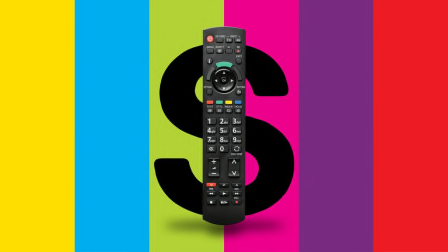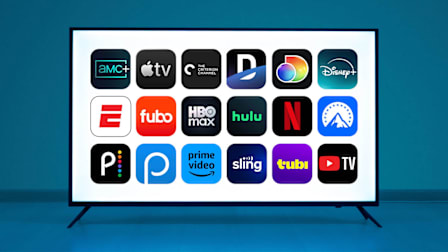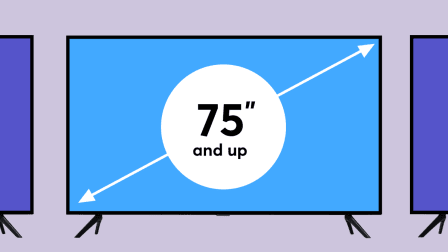Best 4K Streaming Media Devices of 2026, Tested by Experts
Consumer Reports helps you decide which model from Amazon, Apple, Google, Nvidia, Onn, or Roku is right for you
When you shop through retailer links on our site, we may earn affiliate commissions. 100% of the fees we collect are used to support our nonprofit mission. Learn more.
Take a look around your house—there’s a good chance you own one or more smart TVs, with the ability to stream TV shows and movies. About 68 percent of all U.S. homes with internet access now have one, according to research firm Parks Associates. In larger screen sizes, it’s becoming increasingly difficult to find a set that isn’t a smart TV model.
However, that still leaves a lot of people who need a streaming device to access online streaming services, from Amazon Prime and Netflix to Hulu and YouTube TV. Additionally, many of us who have smart TVs opt to add a streaming device. In my own home, four of our five smart TVs are connected to an Amazon Fire TV, Apple TV, or Roku streaming player.
These add-on devices might outperform your smart TV’s built-in system, or they might offer features or services you can’t get from that TV. And if your smart TV is a few years old, you might find that the apps for streaming services you use are outdated or missing altogether.
Four Main Streaming Platforms
The 4K streaming media device market is dominated by just a few software platforms: Amazon Fire TV, Apple TV, Google TV, and Roku. You need to decide on a platform, as well as a specific model.
In general, streaming devices are either set-top models or small stick-style players that plug directly into an HDMI slot on the TV. Prices for the devices listed below range from about $25 to $150. They fluctuate throughout the year, so it pays to look for deals.
The newest 4K models in our streaming media device ratings support high dynamic range (HDR) technology. When done correctly, HDR enhances a TV’s brightness, contrast, and color, making the images on the screen appear more lifelike. It’s an important feature of the best TVs on the market. All these streaming models support the HDR10 format, and most now also support HLG, which is used by some NextGen TV broadcasters in markets where these new over-the-air TV signals are available. More models also support the Dolby Vision and/or HDR10+ formats.
Consumer Reports now includes data privacy and security scores in its ratings for all the streaming devices it tests, in addition to attributes such as ease of use. We evaluate the various ways brands collect, use, and share consumer data, as well as how effectively they protect it, and how transparent the companies are about their data practices.
We also judge companies by how they handle security procedures, such as encrypting all user communications by default, enabling automatic security updates, and protecting against known security vulnerabilities.
The streaming devices listed below are organized alphabetically by platform, with prices ranging from lowest to highest.
Amazon Streaming Players
This stick-style streaming player from Amazon—the Amazon Fire TV Stick 4K Max—is among the company’s fastest, thanks to a more powerful processor, which allows apps to launch quicker than on earlier models. It works on the newer WiFi 6 wireless standard. This model supports the HDR10, HDR10+, HLG, and Dolby Vision HDR formats, as well as Dolby Atmos audio. It comes with an Alexa voice remote, allowing you to find, launch, and control content, as well as change inputs, using voice commands.
Best for: Amazon Prime members who want a speedy stick-style player.
The updated Amazon Fire TV Stick 4K offers a few improvements over the older model, namely a faster processor, which the company says makes it nearly 30 percent more powerful than the model it’s replacing. It also features WiFi 6 wireless technology and supports Dolby Atmos audio, as well as HDR10, HLG, Dolby Vision, and HDR10+ HDR formats. The company says the inclusion of generative AI can help search for and find content more easily by allowing users to ask more nuanced questions in a natural conversational way.
Best for: Fans of the platform who don’t require as much storage or Bluetooth, and are comfortable with WiFi 6 instead of WiFi 6E in the 4K Max.
This is the third iteration of the 4K-ready Fire TV Cube, essentially a mashup of two of Amazon’s popular Alexa-powered devices, the Fire TV streaming player and the Echo Dot smart speaker. As with its predecessors, this Fire TV Cube adds an interesting element into the mix: universal remote control capability for controlling other audio/video gear. Like earlier models, it features Amazon’s Alexa voice assistant. New additions include a faster processor that upscales lower-resolution content to 4K and HDMI 2.1 connections. It also works on the newer WiFi 6e wireless standard. There’s now also an off button that disconnects the microphones if you don’t want to leave the device in an always-listening mode.
Best for: Amazon Prime subscribers who like the Alexa voice assistant and want to control other components. Amazon tends to prioritize its own content, though, when you’re looking for something to watch. Some people might find that annoying.
Apple Streaming Players
Apple TV has always made sense for those who already live in Apple’s world, and the newest Apple TV 4K is no exception. The good news is that the latest models, while still comparatively pricey, are less expensive than their predecessors, and you get more storage. (We tested the 128-gigabyte model; the 64-gigabyte version costs $129.) Also, they support the newer WiFi 6 wireless standard. The only real differences between the two are price and storage, and the 128GB version has an Ethernet jack for a wired connection to your network. Both models have a faster processor and add HDR10+ support in addition to Dolby Vision. (They also support Dolby Atmos 3D sound.) The new Apple TV 4K features a redesigned Siri remote with a clickpad.
Best for: Those who are already invested in the Apple ecosystem and don’t mind paying a premium for an Apple device. With the Apple TV app now available on more devices, including smart TVs and streaming players, owning an Apple TV may become less important than it was in the past.
Google TV/Android Streaming Players
The revamped Google Chromecast, now called Chromecast with Google TV, is a 4K model that supports the HDR10, HDR10+, and Dolby Vision HDR formats. It works on the older WiFi 5 wireless standard. This model comes with a voice remote that has a dedicated button for Google Assistant, the company’s voice-powered digital assistant. Earlier versions lacked a remote control, so users had to rely on a smartphone or tablet to control the player. Note, however, that Google is replacing all its Chromecast players with a brand new, pricier Google TV Streamer (4K) model (see below).
Best for: Anyone who likes the Google TV platform, enjoys controlling other compatible smart devices, and is looking for a lower-priced alternative to Google’s newest model.
As noted above, Google is phasing out its older and cheaper Chromecast streaming devices, replacing them with this new, faster model. The Google TV Streamer (4K) features a sleeker, slanted design, a faster processor, and support for both Dolby Vision and HDR10+ HDR formats, as well as Dolby Atmos audio. It also has twice as much memory (4 gigabytes) and four times as much storage (32GB) as the Chromecast model it replaces. While there’s an Ethernet port for a wired connection, it uses the older WiFi 5 wireless standard rather than WiFi 6, which we’d expect on a new premium model. The player now has a remote-finder feature, and it leverages Google’s AI to make program recommendations.
Best for: Those who already own Google and Matter smart home devices and who want a fast, responsive streaming player.
The Nvidia Shield TV and the pricier Nvidia Shield TV Pro, $199, both have the same fast processor and artificial intelligence upscaling that will convert lower-resolution content to 4K, plus support for Dolby Vision HDR and Dolby Atmos and DTS:X immersive sound. Both systems’ smarts are based on the Android TV platform. There’s built-in support for the voice-powered Google Assistant, and they will work with Amazon Alexa devices. The Shield features a remote-finder button on the unit, a function available only with the Pro model via the Shield TV app. Apart from price, the main differences between the models are related to memory and storage.
Best for: Gamers who also want a solid streaming player with a decent number of features and support for several digital voice assistants, but at a price lower than the Shield TV Pro model.
The Onn 4K Pro Streaming Device, from Walmart’s house brand for electronics, performs well in our tests and offers a range of features—including support for Dolby Vision HDR and Atmos sound—for the price. One unusual aspect of the player is that, much like the Amazon Fire TV Cube, it includes a small speaker that can provide audible responses when the TV is off. The Onn 4K Pro uses the Google TV smart platform, so it has built-in Google Assistant (and Chromecast) and will respond to voice commands. (Both the remote and player have built-in microphones.) It utilizes the newer WiFi 6 wireless standard and features an Ethernet port for a wired connection to your network. It also has a remote-finder feature.
Best for: Those seeking a full-featured Google TV streaming player at a budget-friendly price.
Roku Streaming Players
The Roku Express 4K+, which replaced the Roku Premiere in the company’s lineup, is a compact set-top box that offers 4K picture quality, along with support for both HDR10 and HDR10+ high dynamic range formats, although not Dolby Vision, which is found in some pricier models. The included WiFi voice remote control features TV controls that allow you to turn on the TV, adjust the set’s volume, and use Roku Voice to launch channels, search for content, and control streaming services. Like other Roku players and TVs, it will work with Amazon Alexa and Google Assistant, as well as Apple AirPlay and HomeKit. It uses the slightly older WiFi 5 standard to connect to home networks.
Best for: Roku fans who prefer a set-top box-style player and are willing to compromise on Dolby Vision support.
The Roku Streaming Stick 4K has most of the same features as the more expensive Roku Streaming Stick 4K+ model, including improved WiFi, support for HDR10+ and Dolby Vision HDR, and the ability to work with Amazon Alexa, Apple AirPlay, and Google Assistant voice assistant. It uses the slightly older WiFi 5 standard to connect to home networks. This model comes with a standard Roku remote, but you can upgrade to the Roku Streaming Stick 4K+ model to get the more advanced, rechargeable Voice Remote Pro remote control, which features a built-in headphone jack for private listening, programmable buttons, and a lost-remote finder feature.
Best for: Roku fans who want a stick-style player with numerous features but can do without the Voice Remote Pro to save money.
Roku’s newest 4K streaming player is the Streaming Stick Plus, a compact model that plugs into your TV’s HDMI input and gets power from the TV’s USB port. Unlike the pricier Roku Streaming Stick 4K, this model doesn’t support Dolby Vision HDR or Atmos audio, but it does support HDR10+. It utilizes Roku’s latest version of its simple, easy-to-navigate interface and comes with Roku’s standard Voice Remote.
Best for: Those looking for a relatively inexpensive Roku streamer and don’t require Dolby Vision HDR support.
Like its predecessor, this updated Roku Ultra is the company’s most powerful 4K streaming player. It has a new, faster quad-core processor, quicker app launches, support for both Dolby Vision and HDR10+ HDR formats, and WiFi 6 wireless. Other features include an HDMI 2.1 connection to your TV, an Ethernet port for a wired connection, a lost-remote finder feature, and a wireless headphone mode that lets you pair with Bluetooth headphones. It also has the ability to integrate with Roku Smart Home devices, allowing you to view Roku doorbell or camera feeds on your TV. The new Ultra comes with the new backlit Voice Remote Pro (2nd Edition), which recharges via a USB-C connection.
Best for: Fans of the Roku platform looking for a high-performing flagship player with numerous features.













































